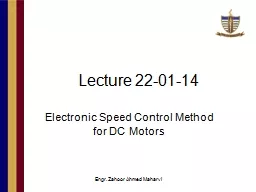

220114 Electronic Speed Control Method for DC Motors Engr Zahoor Ahmed Maharvi Introduction Solid state circuits using semiconductor diodes and thyristors have become very popular for controlling the speed of ID: 238505
Download Presentation The PPT/PDF document "Lecture" is the property of its rightful owner. Permission is granted to download and print the materials on this web site for personal, non-commercial use only, and to display it on your personal computer provided you do not modify the materials and that you retain all copyright notices contained in the materials. By downloading content from our website, you accept the terms of this agreement.
Slide1
Lecture 22-01-14
Electronic Speed Control Method for DC Motors
Engr. Zahoor Ahmed MaharviSlide2
Introduction
Solid state circuits using semiconductor diodes and thyristors have become very popular for controlling the speed of
d.c. motors.Solid state circuits are progressively replacing the traditional electric power control circuits based on thyratrons, ignitrons, mercury arc rectifiers, magnetic amplifiers and motor-generator sets etc.
Engr. Zahoor Ahmed MaharviSlide3
Merits of Electronic Control Circuits
As compared to the electric power control circuits, the electronic control methods have
Higher accuracy
Greater reliabilityQuick responseHigher efficiency as there are no I2R losses and moving parts.Full 4-quadrant speed control is possible to meet precise high speed standards.Engr. Zahoor Ahmed MaharviSlide4
Electronic Speed Control Methods
All electronic control circuits control the motor speed by adjusting either
the voltage applied to the motor armature
the field current, orbothEngr. Zahoor Ahmed MaharviSlide5
D.C. Motors Power Supply
D.C. motors can be run from
d.c. supply if available or from
a.c. supply after it has been converted into d.c. supply with the help of rectifiers which can be either half-wave or full-wave and either controlled (by varying the
conduction
angles of the thyristors used) or uncontrolled.
Engr. Zahoor Ahmed MaharviSlide6
Motor Speed Control using Thyristor Controlled Rectifier
The average output voltage of a
thyristor-controlled rectifier can be changed by changing its
conduction angle and hence the armature voltage of the d.c. motor can be adjusted to control its speed.Engr. Zahoor Ahmed MaharviSlide7
Motor Speed Control using Thyristor Chopper Circuit
When run on a
d.c. supply, the armature d.c. voltage can be changed with the help of a
thyristor chopper circuit which can be made to interrupt d.c. supply at different rates to give different average values of the d.c. voltage. If d.c. supply is not available, it can be obtained from the available a.c
. supply with the help of
uncontrolled rectifiers
(using only diodes and not thyristors). The
d.c
voltages so obtained can be then chopped with the help of a
thyristor
chopper circuit.
Engr. Zahoor Ahmed MaharviSlide8
Uncontrolled Rectifiers
Engr. Zahoor Ahmed MaharviSlide9
Controlled Rectifiers
Engr. Zahoor Ahmed MaharviSlide10
Controlled Rectifiers (contd..)
Engr. Zahoor Ahmed MaharviSlide11
Thyristor Choppers
Engr. Zahoor Ahmed MaharviSlide12
Thyristor Choppers (Contd..)
Engr. Zahoor Ahmed MaharviSlide13
Thyristor Speed Control of a Separately Excited D.C. Motor
Engr. Zahoor Ahmed MaharviSlide14
Thyristor Speed Control of a D.C. Series Motor
Engr. Zahoor Ahmed MaharviSlide15
Full-Wave Speed Control of a Shunt Motor
Engr. Zahoor Ahmed MaharviSlide16
Thyristor Speed Control of a Shunt Motor
Engr. Zahoor Ahmed MaharviSlide17
Thyristor Speed Control of a D.C. Series Motor
Engr. Zahoor Ahmed MaharviSlide18
Engr. Zahoor Ahmed Maharvi
?
Reference
Chapter # 30
Electrical Technology
By B.L.Theraja